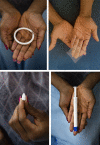End-user preference for and choice of four vaginally delivered HIV prevention methods among young women in South Africa and Zimbabwe: the Quatro Clinical Crossover Study
- PMID: 31069957
- PMCID: PMC6506690
- DOI: 10.1002/jia2.25283
End-user preference for and choice of four vaginally delivered HIV prevention methods among young women in South Africa and Zimbabwe: the Quatro Clinical Crossover Study
Abstract
Introduction: Adherence to HIV prevention methods is a challenge, particularly for young women in Sub-Saharan Africa. End-user research during product development can inform modifiable factors to increase future uptake and adherence.
Methods: Preferences for four vaginally inserted placebo HIV prevention methods were assessed among Zimbabwean and South African young women using a crossover clinical design. For each of months 1 to 4, participants were asked to use a pre-coitally inserted film, insert (vaginal tablet) and gel once/week for a month, and a monthly ring in a randomly assigned sequence. Participants subsequently chose one preferred product to use as directed for the final study month. Women ranked the four products from most preferred to least preferred at enrolment and after trying all products.
Results: A total of 200 women aged 18 to 30 (mean 23) were enrolled; 178 (89%) completed follow-up. At baseline, 41% of participants selected the gel as their most preferred product and 61% selected the ring as least preferred. During the crossover period, most (82% to 85%) self-reported using each product at least once a week, although only half the time with sex. Objective biomarker data confirmed adequate use of all products. After trying each product, rankings changed with the film, ring, insert and gel being selected by 29%, 28%, 26% and 16% respectively. Choice varied significantly by country (p < 0.001): More Zimbabweans chose the film (45%), and more South Africans chose the insert (34%). Among women choosing the ring, 88% reported using it every time with sex. By contrast, self-reported adherence was lower for "on-demand" (coitally associated) products, with 40% to 55% using them every time during sex (p < 0.001).
Conclusions: Preferences for these four dosage forms varied before and after use, and both within and across countries - there was no clear favourite - indicating the need for a range of options for end-users The ring's popularity increased the most with use, was the second most preferred delivery system, and per self-report, provided more coverage during sex. These end-user perspectives provide important information to product developers and funding agencies.
Keywords: PrEP; South Africa; Zimbabwe; adolescents; microbicides; women.
© 2019 RTI International. Journal of the International AIDS Society published by John Wiley & Sons Ltd on behalf of the International AIDS Society.
Figures
References
-
- UNAIDS . Fast‐Track: ending the AIDS epidemic by 2030. Geneva: UNAIDS; 2014.
-
- Peters A, Jansen W, van Driel F. The female condom: the international denial of a strong potential. Reprod Health Matters. 2010;18(35):119–28. - PubMed
-
- AVAC . PrEP Watch 2018. [cited 2018 May 21]. Available from: www.prepwatch.org
-
- AVAC . PrEP Watch 2018. [cited 2018 Jan 3]. Available from: www.prepwatch.org
Publication types
MeSH terms
Substances
Grants and funding
LinkOut - more resources
Full Text Sources
Medical
Miscellaneous


